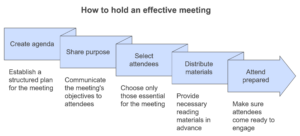1. Re-evaluate meetings to support productivity and morale
For years, teams have kicked off their mornings with meetings—those daily standups intended to get everyone aligned and ready to go. Let’s face it though: for most people, that timing doesn’t sync with when they’re naturally wired for peak productivity. Mornings are high-focus times for a majority of employees, so breaking that period with a meeting can feel like hitting a productivity roadblock before even starting.
Research backs this up. According to a 2022 survey by Coda, 69% of full-time U.S. employees have their most productive hours in the morning—a clear indicator for leaders to rethink the timing and format of meetings. Should a daily standup always happen in real time, or would an asynchronous check-in be more effective? Maybe moving certain updates to later in the day would better respect the natural rhythms of a team’s work.
When we actively guard prime focus time, we’re freeing up schedules and setting people up to do their best work, uninterrupted and at their own pace.
Let’s keep it simple: for most people, mornings are for doing, not discussing. Leaders who recognize this get more from their teams. Starting the day with the hardest or highest-impact work, rather than a meeting, means team members can dive into tasks when their minds are sharpest. A morning meeting might seem small, but it’s more disruptive than it appears, especially for roles that rely on deep concentration. Asynchronous updates, or rescheduling meetings for later in the day, respect those productive hours without sacrificing team alignment.
It’s key to acknowledge each team member’s individual rhythm and constraints. Productivity peaks don’t look the same for everyone. Age, family responsibilities, and even time zones all influence focus times. Leaders should make scheduling decisions that fit the team’s real-world dynamics.
And here’s something most managers overlook: even a five- or ten-minute meeting breaks concentration. In jobs like engineering or design, it can take up to 20 minutes just to regain focus after an interruption. So, a 30-minute meeting? It’s closer to a 50-minute productivity cost. That’s a huge loss, especially when teams need uninterrupted time to tackle complex tasks. Avoid these disruptive meetings and it’ll save time and protect the quality of work.
2. Cluster meetings and setting aside interruption-free time
Meeting clutter is real. A few scattered meetings across the day can break up what could have been a solid stretch of deep work. Clustering meetings together is a smarter way to manage time. When meetings are grouped, they occupy a concentrated period rather than spreading out, giving people extended hours for focused work.
Try holding four 30-minute meetings back-to-back in the morning, instead of spacing them out over several hours. That then frees up additional hours for uninterrupted focus. Clustering alone can reclaim up to two and a half hours of focus time within a 5-hour window. The result? Higher quality output and more efficient use of everyone’s day.
If you want to get a little more creative, what about no-meeting days? Instituting a regular “No Meeting Wednesday” or setting up low-meeting weeks—where 80% of meetings are canceled—gives everyone dedicated time for deep work. When leaders actively participate in these initiatives, they show a commitment to respecting the team’s focus time. It’s a simple but powerful signal that productivity matters over busyness.
3. Improve overall meeting quality and efficiency
Meetings should have a purpose beyond filling time on the calendar. Every meeting must have a clearly defined objective: decision-making, brainstorming, or sharing information. Recurring meetings, in particular, need regular check-ins to confirm they’re still necessary. If not, remove them.
Preparation is key. A well-run meeting starts with a solid agenda. Share the purpose, include only essential attendees, and send any pre-reading materials at least a day before. This lets people come more prepared, so time isn’t wasted on updates that could’ve been read in advance.

How to hold an effective meeting
Then, wrap it up right. When meetings end with summaries, decisions, and clear action items, there’s no confusion on next steps. And if you’ve reached your objectives ahead of time? End the meeting. Don’t just fill up the remaining minutes for the sake of it. The cost of unproductive meetings is real too. According to the Harvard Business Review, 71% of meetings are deemed unproductive, often because they drift off-topic, lack clear follow-through, or don’t have sufficient preparation.
4. Balance necessary meetings with asynchronous communication
Not every meeting needs to be a live event. In our current remote, asynchronous work world, meetings should only be held when they truly add value. The goal is to align priorities, clarify big-picture goals, or tackle issues that require immediate input. Everything else can likely be handled through email or asynchronous updates.
Protecting time for deep work is a must.
For knowledge workers, big blocks of uninterrupted time are invaluable. Asynchronous updates, where team members provide status updates or share insights on their own schedule, lets teams stay aligned without constant interruptions. When we guard focus time, especially for knowledge workers, we’re respecting each person’s ability to do their best work. The payoff is tangible: higher-quality work, lower stress, and a team that feels their time and talent are valued.
Final thoughts
Are your meetings genuinely moving your team forward, or are they just filling up the calendar? Don’t just meet for the sake of it. Are you ready to redesign the way your teams work, creating a culture where meetings fuel innovation, cut through the noise, and amplify productivity? Your team’s time and focus are the ultimate resources. How will you invest them?





